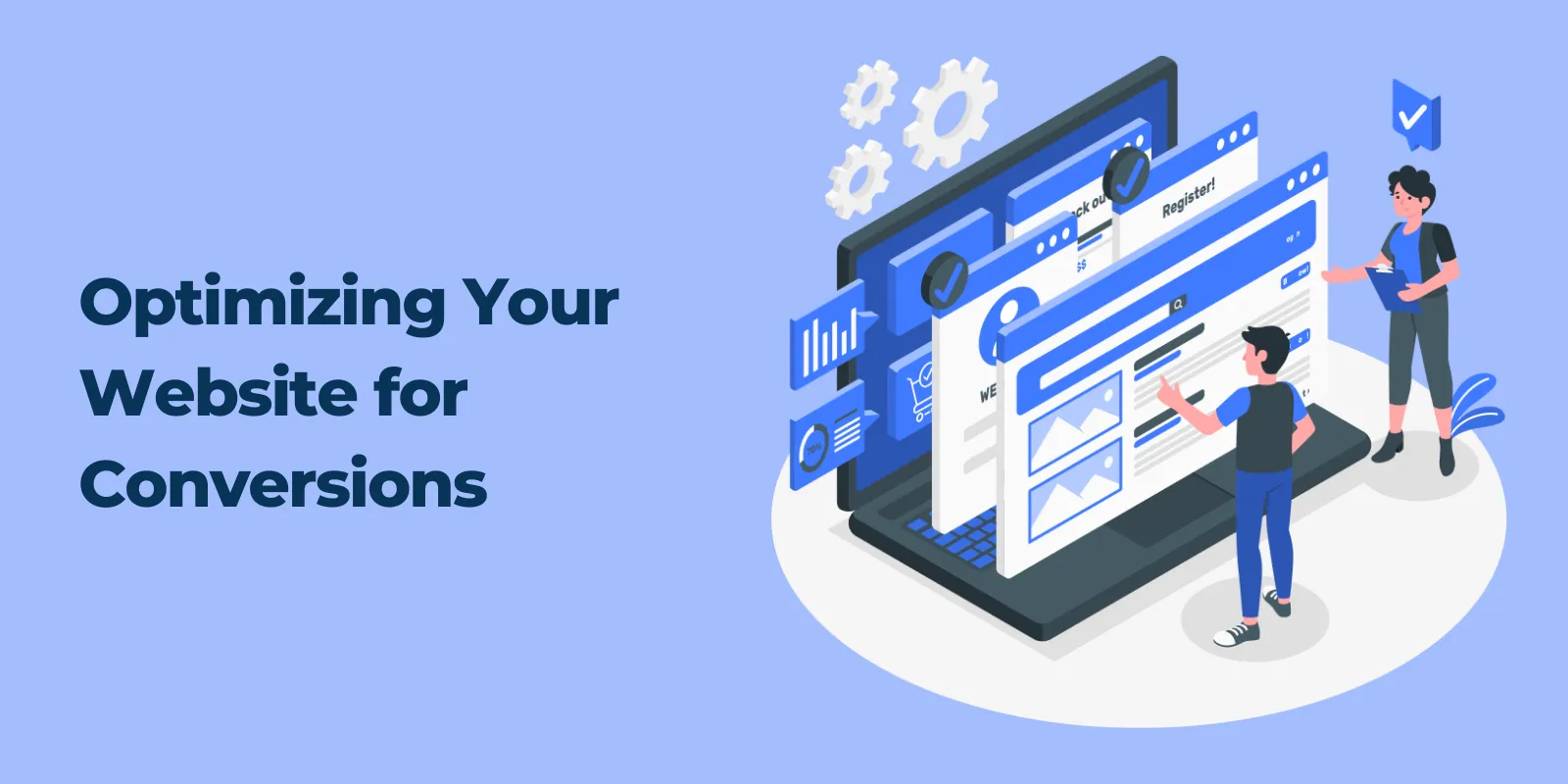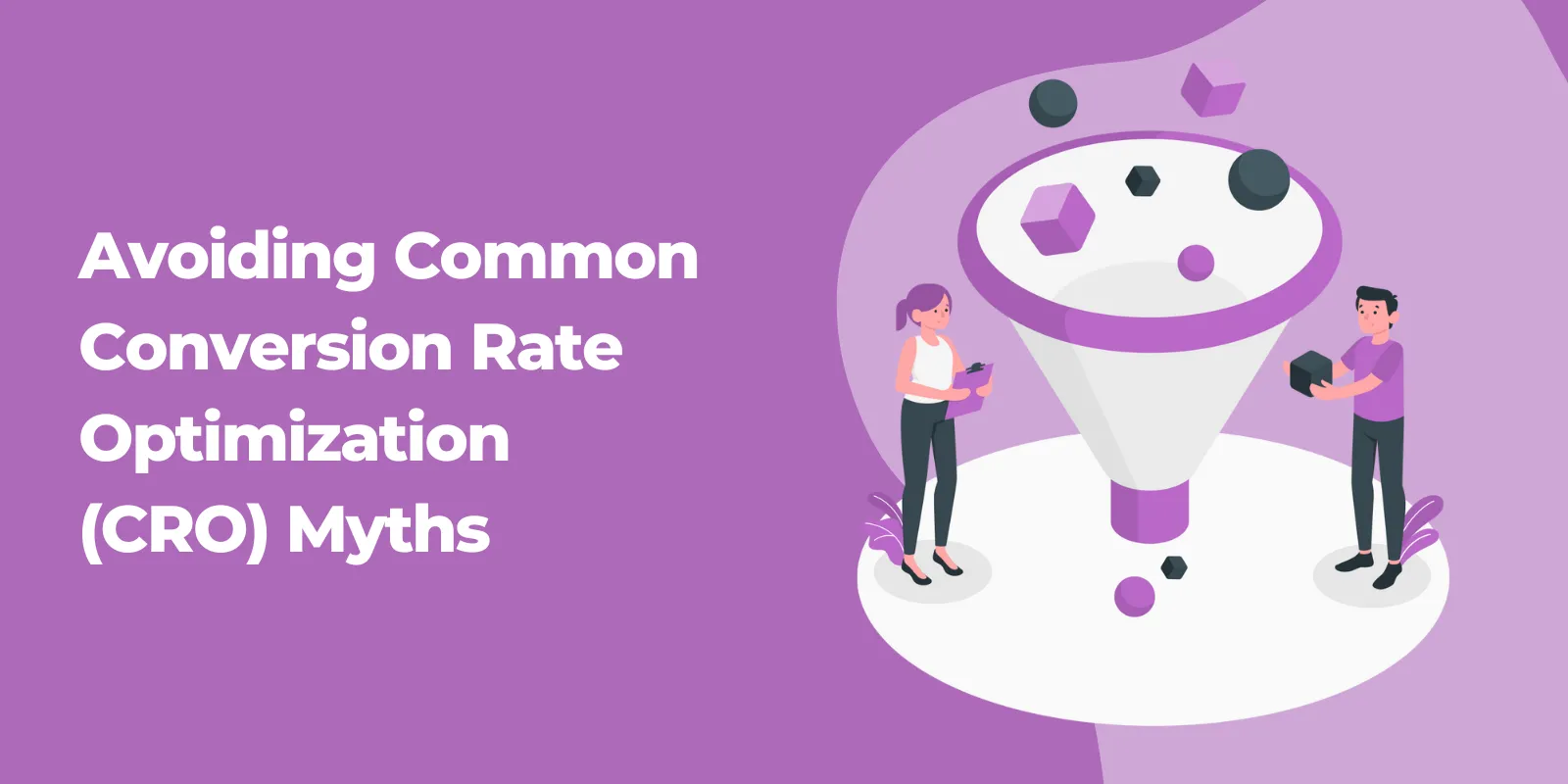Many businesses face the same challenge.
But fear not, uncovering the reasons behind “why your website isn’t converting leads into customers and how to fix it” can be a game-changer for your online business.
In this blog post, we will delve into common roadblocks preventing conversions, share actionable tips for optimizing your website, discuss the role of content, and debunk prevalent myths surrounding conversion rate optimization (CRO).
Let’s embark on this journey together to transform your website into a conversion powerhouse.
Identifying the Conversion Roadblocks
It’s crucial to understand why your website isn’t converting leads into customers before investing in redesign or marketing initiatives.
Inadequate messaging, subpar user experience, and insufficient trust indicators are some of the key issues that can impede conversions.
Additionally, a website’s conversion rate can drastically impact revenue, as an increase in the conversion rate directly corresponds to a doubling of revenue generated from the website.
By addressing these roadblocks, you can create a more effective and engaging website that caters to your target audience’s needs and expectations.
This not only helps in converting leads quickly, but also improves overall user satisfaction, which can result in long-term customer loyalty.
Misaligned Messaging
Misaligned messaging occurs when the message on your website does not align with the needs of the target audience, potentially leading to confusion and a lack of conversions.
Assessing for inconsistencies in messaging, such as unclear calls-to-action, confusing navigation, and irrelevant content, is vital to identify this issue.
In additon, signs of user frustration, such as high bounce rates and low time on page, should be taken into consideration.
To address misaligned messaging, website owners should prioritize creating a unified message throughout the website. Refining the user journey, optimizing calls-to-action, and exploring A/B testing can be incredibly beneficial in this regard.
For instance, Michael, a website owner, observed an improvement in conversion rate after removing visual distractions from his website. Embracing a tailored approach to messaging ultimately leads to a better understanding of your target audience and fosters higher conversion rates.
Poor User Experience
A decrease in conversion rates can be seen as a result of visitors leaving the website due to slow loading times and complex navigation. In this age of mobile traffic, it’s vital not to disregard the importance of mobile devices in your digital marketing strategy.
By designing for mobile and ensuring compatibility across different devices and browsers, you can cater to a wider audience and improve user experience.
An intuitive cart feature is critical to facilitate the buying process for users and boost conversions.
Additionally, visual clutter, excessive fonts, and overwhelming choices on a website can negatively impact the user experience, ultimately reducing website conversion rates.
By focusing on creating a seamless and enjoyable user experience, you can guide your site visitors smoothly through the purchasing process and increase the likelihood of conversions.
Lack of Trust Signals
Establishing credibility and trust with potential customers is essential in improving conversion rates.
Social proof, such as testimonials and reviews, can play a significant role in building that trust. By demonstrating the worth of your product and highlighting its distinct advantages, you can make your customers feel confident in their decision to choose your product or service.
However, having testimonials on a separate page may not be as effective, as it reduces the visibility of social proof and can lead to visitors bypassing them.
Integrating testimonials and trust badges throughout your website, especially on key pages such as product pages or landing pages, can go a long way in building credibility and increasing conversions.
Optimizing Your Website for Conversions
Now that we’ve identified the roadblocks preventing conversions, let’s focus on actionable tips and strategies to improve your website’s conversion rate.
Implementing a comprehensive approach to conversion rate optimization, including streamlining the user journey, enhancing calls-to-action, and utilizing A/B testing, can significantly improve your website’s performance and lead generation.
Moreover, creating an SEO strategy can help drive more traffic to your site and increase familiarity with the products or services offered. This, combined with high-quality, compelling content, can result in a significant boost in conversions.
Streamlining the User Journey
A clear and intuitive user journey is essential for guiding visitors toward conversion. By focusing on the user’s needs and goals, you can design a website that is not only pleasing to the eye but also provides a streamlined experience for your visitors.
Identifying the key steps in the user’s journey and ensuring they are easy to understand and navigate is crucial.
Visuals and other design elements can be used to guide the user through the journey, making it more engaging and memorable.
Additionally, optimizing calls-to-action (CTAs) can direct users to the desired action and improve the overall user experience.
By focusing on creating a seamless user journey, you can increase the likelihood of converting leads into customers.
Enhancing Calls-to-Action (CTAs)
Compelling and visible calls-to-action (CTAs) are crucial for guiding website visitors toward conversion.
CTAs should be action-oriented, easily located, and visually distinct to ensure they capture the attention of your visitors.
Additionally, testing different CTAs can help determine which yields the best results and allows you to optimize your website accordingly.
Examples of successful CTAs include altering the color of a call-to-action button, incorporating a customer testimonial, or altering the positioning of a form.
By refining your CTAs, you can create a more engaging website that encourages conversions and ultimately boosts your online business.
Utilizing A/B Testing
A/B testing is a powerful tool for evaluating the effectiveness of different website elements in driving conversions.
By testing two versions of a webpage or app simultaneously and measuring which one yields higher conversions, you can optimize your website for better performance.
Setting up an A/B test involves identifying the goal of the test, creating the two versions of the page, configuring the test, executing the test, and evaluating the results.
Successful A/B tests can include altering the color of a call-to-action button, incorporating a customer testimonial, or altering the positioning of a form. By utilizing A/B testing, you can make data-driven decisions that lead to a more effective and engaging website.
The Role of Content in Converting Leads
Content plays a crucial role in attracting and converting leads into customers. High-quality, relevant content can not only drive more traffic to your website, but also build trust and credibility with your target audience.
By crafting engaging copy, addressing customer pain points, and leveraging visuals and media, you can create a website that resonates with your audience and encourages conversions.
Understanding the buyer’s journey and following up with leads is essential in transforming them into customers.
In fact, delaying contact with a lead for more than 10 minutes can reduce the likelihood of a successful sale by 400%. It’s recommended that sales teams follow up with a lead at least six times before discontinuing contact.
Crafting Engaging Copy
Writing persuasive copy that resonates with your target audience is vital for encouraging conversions.
Engaging copy should be tailored to the target audience, tell a compelling story, and be written in a manner that resonates with humans. Additionally, it should be straightforward, evoke emotion, and remain consistent.
Developing copy that is tailored to the target audience ensures that the message is effectively communicated and encourages conversions.
Storytelling is an effective tool for captivating readers and communicating your message in a meaningful manner, facilitating the formation of an emotional bond with your audience and motivating them to take action.
Addressing Customer Pain Points
Understanding and addressing customer pain points is crucial for creating content that resonates with your audience and encourages conversions.
By providing helpful information, resources, and guidance, you can offer solutions to customer pain points and establish trust and credibility.
Examples of successful customer pain point solutions include offering useful resources and instructions on how to use a product, or providing helpful information and resources on how to resolve a particular issue.
By focusing on addressing customer pain points through your content, you can create a website that not only attracts leads but converts them into loyal customers.
Leveraging Visuals and Media
Visuals, videos, and multimedia can significantly enhance content engagement and boost conversions. By incorporating visually appealing elements into your content, you can emphasize the primary points and make it more engaging and memorable for your viewers.
Effective visuals and media include using images to illustrate a point, employing videos to explain a concept, and utilizing infographics to present data.
By leveraging visuals and media in your content, you can create a more engaging website that resonates with your target audience and encourages conversions.
Implementing Analytics and Tracking Tools
Analytics and tracking tools can help you identify areas for improvement and measure the success of your optimization efforts.
By collecting data regarding website visitors and their behavior, you can gain insights into how visitors interact with your website and which pages are most popular.
Utilizing web analytics tools can help you gain an understanding of what is occurring on your website and gain insights on what is working (and what is not).
Implementing analytics and tracking tools allows you to monitor changes in website activity, such as page views, time on page, and user clicks, and evaluate whether your optimization efforts are yielding the desired results.
By understanding key conversion metrics and setting up goal tracking, you can better evaluate the performance of your website and make data-driven decisions to improve your conversion rates.
Understanding Key Conversion Metrics
Key conversion metrics include lead inquiries, click-through rate (CTR), sales and revenue, as well as cost per acquisition (CPA).
Other important metrics include interactions per visit, leads generated, new visitor conversion rate, and returning visitor conversion rate.
The conversion rate is a key performance indicator that can be used to evaluate the effectiveness of campaigns and landing pages.
By monitoring these essential conversion metrics, you can gain valuable insights into the performance of your website and identify areas for improvement.
This information can be used to make data-driven decisions and optimize your website for better conversions and increased revenue.
Setting Up Goal Tracking
Setting up goal tracking in Google Analytics allows you to monitor the progress of your conversion efforts and measure how often users complete specific actions on your website or app.
To set up goal tracking, you must create a goal in the Admin section of your Google Analytics account, specifying the goal type, goal details, and goal value.
After the goal is created, you can monitor progress towards its achievement in the Conversions section of your Google Analytics account.
By tracking the progress of conversions using goal tracking, you can view details such as the number of times users have completed the goal you have set up, goal value, goal conversion rate, and goal abandonment rate.
This information can be invaluable in evaluating the success of your optimization efforts and making informed decisions to improve your website’s performance.
Analyzing User Behavior
Analyzing user behavior can provide valuable insights for optimizing your website and increasing conversions.
By evaluating how users interact with your website, such as their preferences, engagement, user journey, and drop-off points, you can identify areas for improvement and enhance the overall user experience.
Leveraging user behavior analysis can help you optimize your website and increase conversions by optimizing user experience, streamlining the user journey, optimizing calls-to-action, and incorporating visuals and media.
By understanding how users interact with your website, you can make data-driven decisions that lead to a more effective and engaging website.
Avoiding Common Conversion Rate Optimization (CRO) Myths
It’s important to be aware of prevalent CRO myths that may hinder website owners from achieving optimal conversion rates.
One such myth is that more traffic automatically leads to more conversions. In reality, traffic is only one of the many elements that contribute to conversions, and other factors such as content, navigation, and engagement tools are more influential.
Another common misconception is that one-size-fits-all best practices exist for website optimization.
In fact, what works for one website may not work for another, as each website has distinctive traffic sources, branding, and customers.
Taking a tailored approach to optimization and measuring the results can lead to a more successful and engaging website.
Myth: More Traffic Equals More Conversions
Increasing traffic alone does not guarantee higher conversion rates, as it is only one of the many elements that contribute to conversions.
Addressing the conversion rate can result in a significant increase in total conversions and revenue, without having to significantly boost traffic.
It is advised to address the conversion rate and become satisfied with it prior to increasing website traffic. By focusing on optimizing your website for conversions, you can create a more effective and engaging website that caters to your target audience’s needs and expectations.
Myth: One-Size-Fits-All Best Practices
The misconception that one-size-fits-all best practices exist is the notion that a single set of strategies or techniques can be applied to all websites to enhance their performance, disregarding their individual characteristics and target audience.
Relying solely on generic best practices for website optimization may not yield the desired results, as website optimization requires a tailored approach that considers the specific goals, audience, and context of each website.
By taking a tailored approach, you can ensure that your website optimization efforts are targeted and effective, leading to improved performance and higher conversion rates.
Measuring and validating your website optimization approaches is essential for determining what works best for your unique website and target audience.
Case Studies: Successful Website Conversion Strategies
Real-life examples of businesses that have successfully improved their website conversion rates through various strategies and tactics can serve as valuable inspiration.
Some of these strategies include defining site goals, personalizing messages, eliminating superfluous form fields, incorporating testimonials and reviews, crafting a captivating user experience, collecting feedback, testing various approaches, optimizing pricing and payment options, and leveraging social media and email marketing.
By learning from these successful strategies, you can tailor your own website optimization efforts to better serve your target audience and increase conversions.
Continuously refining and testing different approaches can help you stay ahead of the competition and ensure that your website remains an effective and engaging platform for converting leads into customers.
As a digital marketer, I’ve always been fascinated with keyword research. It’s one of the most important aspects of SEO that helps in driving organic traffic to a website.
If you’ve ever wondered how keyword research can help boost your website’s traffic, then you’re in the right place.
In this comprehensive guide, we’ll dive deep into the world of keyword research and uncover the secrets that can give your website an edge in search engine rankings.
So, let’s get started!
Understanding the Importance of Keyword Research
Keyword research is crucial for any successful SEO strategy. It involves identifying relevant and popular search terms that your target audience uses on search engines. By optimizing your website’s content for these keywords, you can increase your website’s visibility, drive more organic traffic, and ultimately boost your website’s conversions.
With 61% of marketers saying that improving SEO and growing their organic presence is their top inbound marketing priority, it’s clear that keyword research is essential.
When you prioritize keyword research, you’re able to focus on high-potential keywords that drive targeted traffic to your site. Understanding user intent helps you create content that meets their needs and aligns with their search queries.
Keyword research also helps you regularly explore new market opportunities and niches, keeping you ahead of the competition. Additionally, prioritizing keywords based on their search volume, competition, and relevance to your business allows for a more effective SEO strategy.
It’s essential to continuously improve your website’s overall SEO performance by tracking keyword rankings and optimizing your content. By identifying keyword gaps between your website and competitors, you can uncover new opportunities for growth.
Staying adaptable and updating your SEO strategy based on changing search trends and user behavior is also key to staying ahead in the world of SEO.
Considering that 70-80% of users ignore paid search ads and focus on organic search results, the importance of keyword research in your overall SEO strategy is undeniable. Now, let’s dive into some actionable tips for making the most of keyword research.
7 Actionable Keyword Research Tips:
- Focus on high-potential keywords that can drive targeted traffic to your site.
- Understand user intent to create content that meets their needs and aligns with their search queries.
- Regularly explore new market opportunities and niches to stay ahead of the competition.
- Prioritize keywords based on their search volume, competition, and relevance to your business.
- Continuously improve your website’s overall SEO performance by tracking keyword rankings and optimizing your content.
- Identify keyword gaps between your website and competitors to uncover new opportunities.
- Stay adaptable by updating your SEO strategy based on changing search trends and user behavior.
Getting Started with Keyword Research: Identifying Your Seed Keywords
Seed keywords are the foundation of your keyword research process. They help you generate new keyword ideas and discover long tail keywords that can drive targeted traffic to your site.
When you start the process of identifying your seed keywords, you should brainstorm a list of words and phrases related to your products or services. By analyzing your competitors’ websites and looking at the keywords they’re targeting, you can gain valuable insights into the most relevant keywords for your niche.
Another great way to find seed keywords is by using keyword research tools, such as Google Keyword Planner, which can help you identify high-potential keywords based on search volume, competition, and relevance.
By focusing on seed keywords, you’re able to create a solid foundation for your keyword research and build a more effective SEO strategy.
Once you have a list of seed keywords, you can then use keyword research tools to find related long tail keywords. Long tail keywords are longer and more specific phrases that are less competitive and often have lower search volumes than short, generic keywords.
However, they often have higher conversion rates, as they target users who are closer to making a purchase decision. By targeting long tail keywords, you can increase your chances of ranking higher in search engine results pages (SERPs) and attracting more targeted traffic.
To create a comprehensive list of long tail keywords, you should use keyword research tools like Google Keyword Planner, SEMrush, or Ahrefs.
These tools can help you identify relevant long tail keywords based on your seed keywords, search volume, and competition.
Additionally, using Google Search Console and Google Analytics can provide valuable insights into the keywords that are already driving traffic to your website, helping you identify potential opportunities for improvement.
Analyzing the search intent behind specific keywords is another crucial step in the keyword research process. Understanding whether users are looking for informational, transactional, or navigational content can help you create content that meets their needs and improves your chances of ranking higher in SERPs.
Now that we’ve discussed the importance of seed keywords and long tail keywords, let’s look at some actionable tips for identifying your seed keywords and conducting effective keyword research.
7 Actionable Identifying Your Seed Keywords Tips:
- Brainstorm a list of words and phrases related to your products or services.
- Analyze competitors’ websites to identify the keywords they’re targeting.
- Use keyword research tools to find high-potential seed keywords based on search volume, competition, and relevance.
- Expand your seed keyword list by finding related long tail keywords using keyword research tools.
- Analyze the search intent behind specific keywords and create content that meets user needs.
- Monitor your website’s performance using Google Search Console and Google Analytics to identify opportunities for improvement.
- Continuously update your keyword list and SEO strategy based on changing search trends and user behavior.
Evaluating Keyword Difficulty
Keyword difficulty is an essential metric to consider when conducting keyword research, as it gives you an idea of how hard it will be to rank for a specific keyword.
Higher keyword difficulty scores indicate that it will be more challenging to rank for lower scores suggest that it may be easier to achieve higher rankings.

Award-Winning
Sales Funnel & Website Expert
Discover How My Agency Can Grow Your Business
- Website: Our websites are the perfect blend of form and function.
- Sales Funnel: We build sales funnels that turn leads into customers.
- SEO: Get found online with our expert SEO services.
According to Ahrefs, 90.63% of pages get no organic search traffic from Google, which highlights the importance of selecting the right keywords with manageable difficulty levels.
Research also shows that the average time it takes for a new page to reach the top 10 search results on Google is about 2 years.
When evaluating keyword difficulty, keep these factors in mind:
- Check the competition
Analyze the top-ranking pages for a specific keyword and assess their content quality, domain authority, and backlink profiles. This will give you an idea of what you need to do to outrank them.
- Understand search intent
Make sure that your content aligns with the search intent behind the keyword. This will help you create content that satisfies user needs and has a higher chance of ranking well. - Consider your domain authority
Your website’s domain authority plays a significant role in determining how hard it will be to rank for a specific keyword. Websites with higher domain authority have a better chance of ranking for more competitive keywords.
7 Actionable Evaluating Keyword Difficulty Tips:
- Use keyword research tools like Ahrefs or SEMrush to get keyword difficulty scores.
- Look for long-tail keywords with lower keyword difficulty scores, as they are usually less competitive and easier to rank for.
- Focus on creating high-quality, in-depth content that addresses the search intent behind your target keyword.
- Work on improving your website’s domain authority by earning high-quality backlinks and optimizing your on-page SEO.
- Monitor your keyword rankings regularly and adjust your strategy as needed.
- Don’t be afraid to target more competitive keywords if you have a strong domain authority and a solid SEO strategy in place.
- Be patient and consistent with your SEO efforts, as it may take time to see results.
Utilizing Google Keyword Planner
Google Keyword Planner is a free keyword research tool provided by Google Ads. It’s primarily designed for advertisers but can also be a valuable resource for SEO keyword research.
According to Google, their Keyword Planner helps users find an average of 332 new keywords per search.
To use Google Keyword Planner for keyword research, follow these steps:
- Sign in to your Google Ads account (or create one if you don’t have one).
- Navigate to the “Keyword Planner” under the “Tools & Settings” menu.
- Select “Discover new keywords” and enter your seed keyword or a URL related to your industry.
- Review the keyword ideas provided, along with their search volumes, competition levels, and other relevant metrics.
7 Actionable Utilizing Google Keyword Planner Tips:
- Use Google Keyword Planner to find new keyword ideas based on your seed keyword or a competitor’s URL.
- Look for keywords with high search volumes and low competition, as they can provide excellent opportunities for ranking.
- Pay attention to the “Top of page bid” metric, as it can give you an idea of how competitive a keyword is in terms of paid advertising.
- Export your keyword ideas to a spreadsheet for further analysis and organization.
- Combine data from Google Keyword Planner with other keyword research tools to get a more comprehensive view of potential keywords.
- Use the “Refine keywords” feature to filter your keyword ideas based on specific criteria, such as search volume or competition.
- Keep an eye on trends and seasonality in the keyword planner to identify potential opportunities for timely content creation.
Incorporating Monthly Search Volume
Monthly search volume is a crucial metric to consider when conducting keyword research, as it indicates how many times a particular keyword is searched for on average per month.
Targeting keywords with high monthly search volumes can lead to increased organic traffic, while targeting low-volume keywords may not generate significant results.
A study by Ahrefs found that the top-ranking page for a keyword gets 31.7% of the clicks, emphasizing the importance of targeting high search volume keywords to maximize traffic.
When incorporating monthly search volume into your keyword research strategy, keep the following points in mind:
- Balance search volume with keyword difficulty
While it’s essential to target high search volume keywords, it’s also crucial to balance that with the keyword difficulty to ensure that you have a realistic chance of ranking.
- Focus on long-tail keywords
Long-tail keywords typically have lower search volumes, but they are less competitive and can drive highly targeted traffic to your website. They often convert better, as users searching for long-tail keywords tend to be further along in the buying cycle.
- Don’t ignore low search volume keywords
Although high search volume keywords can drive more traffic, don’t disregard low search volume keywords altogether, as they can still provide valuable traffic and contribute to your overall SEO strategy.
7 Actionable Incorporating Monthly Search Volume Tips:
- Use keyword research tools like Ahrefs, SEMrush, or Google Keyword Planner to find monthly search volume data for your target keywords.
- Analyze the search volume trends to identify seasonal fluctuations or emerging keyword opportunities.
- Focus on a mix of high and low search volume keywords to create a balanced SEO strategy.
- Keep an eye on your competitors’ keyword rankings to identify potential high search volume keywords that they may be overlooking.
- Continuously monitor your keyword rankings and adjust your content strategy as needed to target higher search volume keywords.
- Incorporate long-tail keywords into your content to drive targeted traffic with potentially higher conversion rates.
- Remember that search volume is just one factor to consider when selecting keywords; always balance it with keyword difficulty, search intent, and your website’s domain authority.
Leveraging Google Search Console
Google Search Console is a free tool provided by Google that allows you to monitor and maintain your website’s presence in Google’s search results. It’s an invaluable resource for keyword research, as it provides insights into how your website is performing in terms of organic search traffic.
According to Google, over 5 billion searches are performed on their platform each day, making it essential to leverage Google Search Console to optimize your website for search engines.
To use Google Search Console for keyword research, follow these steps:
- Verify your website with Google Search Console, if you haven’t already.
- Navigate to the “Performance” report to view data on your website’s search performance, including clicks, impressions, click-through rate (CTR), and average position.
- Analyze the “Queries” section to see which keywords your website is currently ranking for and identify opportunities for improvement.
7 Actionable Leveraging Google Search Console Tips:
- Regularly review your Google Search Console data to monitor your website’s search performance and identify areas for optimization.
- Analyze the keywords your website is ranking for to uncover potential content gaps or keyword opportunities that you may not have considered.
- Monitor the CTR and average position metrics to identify keywords that may require further optimization to improve their rankings or click-through rates.
- Use the “URL Inspection” tool to request indexing for new or updated content to ensure that it appears in Google’s search results.
- Set up email notifications in Google Search Console to stay informed about any issues or updates related to your website’s search performance.
- Leverage the “Links” report to analyze your website’s backlink profile and identify opportunities for earning high-quality backlinks.
- Combine data from Google Search Console with other keyword research tools and analytics platforms to gain a comprehensive understanding of your website’s search performance and keyword opportunities.
Exploring Keyword Ideas
Coming up with new keyword ideas is an essential part of the keyword research process, as it allows you to identify potential opportunities for driving traffic and improving your website’s search rankings.
Research shows that 15% of daily searches on Google are completely new, emphasizing the need to constantly explore new keyword ideas.
When exploring keyword ideas, consider the following techniques:
- Analyze competitors:
Review the keywords your competitors are targeting and ranking for to identify potential opportunities for your own website.
- Use keyword research tools
Tools like Ahrefs, SEMrush, and Google Keyword Planner can help you discover new keyword ideas based on your seed keywords or industry.
- Consider search intent
Make sure the keywords you choose align with the search intent of your target audience to ensure that your content satisfies their needs.
7 Actionable Exploring Keyword Idea Tips:
- Regularly analyze your competitors’ keyword rankings to stay informed about new keyword opportunities in your industry.
- Use keyword research tools to generate new keyword ideas and expand your keyword list.
- Incorporate long-tail keywords into your keyword strategy, as they can drive highly targeted traffic and are often less competitive.
- Focus on creating content that aligns with the search intent behind your target keywords to improve your chances of ranking well.
- Keep an eye on industry trends and news to identify emerging keyword opportunities related to your niche.
- Collaborate with your team or engage in brainstorming sessions to come up with new keyword ideas.
- Don’t be afraid to experiment with different keyword combinations and variations to discover untapped opportunities for driving traffic and improving your search rankings.
Understanding Search Intent
Search intent, also known as user intent, is the primary goal a user has when typing a query into a search engine. Understanding search intent is crucial for effective keyword research, as it helps ensure that your content aligns with the needs and expectations of your target audience.
A study by Moz found that 80% of search results on Google are informational, demonstrating the importance of catering to search intent when creating content.
When considering search intent, keep these points in mind:
- Identify the primary goal of users searching for a specific keyword
Are they looking for information, trying to make a purchase, or seeking a particular website?
- Align your content with the search intent
Make sure your content addresses the needs and goals of users searching for your target keyword to improve your chances of ranking well and driving targeted traffic.
7 Actionable Understanding Search Intent Tips:
- Analyze the top-ranking pages for your target keywords to gain insights into the search intent behind those keywords.
- Create content that caters to the search intent of your target keywords, ensuring that it satisfies the needs and expectations of your audience.
- Use keyword modifiers (e.g., “how to,” “best,” “compare”) to help identify the search intent behind specific keyword phrases.
- Monitor user engagement metrics (e.g., bounce rate, time on page) to assess whether your content is effectively addressing the search intent.
- Continuously update and optimize your content to better align with search intent and improve your search rankings.
- Incorporate different content formats (e.g., blog posts, videos, infographics) to cater to various search intents and user preferences.
- Experiment with targeting different search intents to identify opportunities for driving traffic and improving your website’s search performance.
Leveraging Google Ads for Keyword Research
Google Ads is a powerful advertising platform that can also be an invaluable resource for keyword research. By analyzing the performance of your Google Ads campaigns, you can gain insights into which keywords are driving the most traffic and conversions for your website.
Google Ads data can help you make informed decisions when selecting keywords for your SEO strategy.
A study by WordStream found that the average click-through rate for Google Ads is 3.17%, emphasizing the importance of targeting the right keywords in your campaigns.
When using Google Ads for keyword research, consider the following:
- Analyze your campaign data
Use the data from your Google Ads campaigns to identify high-performing keywords and incorporate them into your SEO strategy.
- Test different keywords
Experiment with various keyword combinations and variations in your ads to determine which ones perform the best.
7 Actionable Leveraging Google Ads for Keyword Research Tips:
- Regularly review your Google Ads campaign data to identify high-performing keywords and adjust your SEO strategy accordingly.
- Test different keyword combinations and variations in your ads to determine which ones drive the most traffic and conversions.
- Monitor changes in the performance of your target keywords in Google Ads and adjust your SEO strategy as needed.
- Use Google Ads data to identify high-converting long-tail keywords and incorporate them into your SEO strategy.
- Experiment with various ad formats and targeting options to identify the best-performing keywords for your website.
- Use the Google Ads Keyword Planner tool to discover new keyword ideas and assess their potential for driving traffic and conversions.
- Continuously optimize your Google Ads campaigns and SEO strategy to maximize the performance of your target keywords and increase your website’s traffic.
Utilizing Google Analytics for Keyword Insights
Google Analytics is a powerful web analytics tool that can provide valuable insights into your website’s traffic, user behavior, and the performance of your SEO efforts.
By analyzing the data in Google Analytics, you can gain a better understanding of which keywords are driving the most traffic and conversions for your website, helping you refine your keyword strategy and optimize your content for better search rankings.
According to a study by Econsultancy, 56% of businesses rely on Google Analytics to measure their SEO performance.
When using Google Analytics for keyword insights, consider these points:
- Analyze your organic search traffic
Use Google Analytics to identify the keywords driving the most organic traffic to your website and focus on optimizing your content for those keywords.
- Monitor user behavior:
Analyze how users interact with your website when they arrive via specific keywords to identify areas for improvement and optimize your content accordingly.
7 Actionable Utilizing Google Analytics for Keyword Insights Tips:
- Regularly review your Google Analytics data to identify high-performing keywords and adjust your SEO strategy accordingly.
- Monitor changes in the performance of your target keywords in Google Analytics and adjust your SEO strategy as needed.
- Use Google Analytics data to identify high-converting long-tail keywords and incorporate them into your SEO strategy.
- Analyze user behavior data in Google Analytics to identify areas for improvement and optimize your content for better search rankings.
- Set up custom reports and alerts in Google Analytics to monitor the performance of your target keywords and stay informed of any changes.
- Use Google Analytics data in conjunction with other keyword research tools to gain a comprehensive understanding of your keyword performance.
- Continuously optimize your content and website based on the insights gained from Google Analytics to improve your search rankings and drive more traffic to your website.
Exploring Google Trends for Keyword Ideas
Google Trends is a powerful tool that allows you to analyze the popularity of search queries over time. By examining the trends of specific keywords, you can identify seasonal fluctuations, emerging trends, and potential opportunities for your SEO strategy.
A study by HubSpot found that 61% of marketers believe that Google Trends is useful for identifying trends and opportunities in their industry.
When using Google Trends for keyword research, consider these points:
- Analyze the search trends
Use Google Trends to identify search trends and fluctuations for your target keywords, which can help you optimize your content for specific seasons or events.
- Discover related queries
Google Trends can also show you related search queries, giving you additional keyword ideas to incorporate into your SEO strategy.
7 Actionable Exploring Google Trends for Keyword Ideas Tips:
- Use Google Trends to identify search trends and fluctuations for your target keywords to optimize your content for specific seasons or events.
- Monitor emerging trends in your industry using Google Trends to stay ahead of your competition and capitalize on new opportunities.
- Explore related search queries in Google Trends to discover additional keyword ideas and expand your SEO strategy.
- Analyze the geographic distribution of search trends to tailor your content and SEO strategy for specific regions or markets.
- Use Google Trends data in conjunction with other keyword research tools to gain a comprehensive understanding of your keyword performance.
- Monitor the performance of your target keywords in Google Trends and adjust your SEO strategy as needed.
- Continuously optimize your content and website based on the insights gained from Google Trends to improve your search rankings and drive more traffic to your website.
Prioritizing Keywords for Your SEO Strategy
Once you’ve conducted your keyword research and generated a list of potential target keywords, it’s essential to prioritize them based on their relevance, search volume, and competition.
By focusing your efforts on the most valuable keywords, you can maximize your SEO results and drive more traffic to your website.
A study by Ahrefs found that 90.88% of all pages in their index receive no organic search traffic, highlighting the importance of prioritizing your keywords effectively.
When prioritizing keywords for your SEO strategy, consider these points:
- Evaluate keyword relevance
Ensure that your chosen keywords are highly relevant to your content, products, or services to attract the right audience and improve your chances of conversion.
- Analyze search volume: Prioritize keywords with higher search volume to capture a larger share of potential traffic.
7 Actionable Prioritizing Keywords for Your SEO Strategy Tips:
- Create a spreadsheet or use a keyword research tool to organize and prioritize your target keywords based on relevance, search volume, and competition.
- Focus your efforts on high-relevance, high-search volume, and low-competition keywords to maximize your SEO results and drive more traffic to your website.
- Continuously update your keyword prioritization as your business evolves, new trends emerge, and search volume or competition levels change.
- Use a combination of short-tail and long-tail keywords to target a diverse range of search queries and attract a broad audience.
- Regularly review and update your keyword prioritization based on the performance of your target keywords and the latest SEO best practices.
- Incorporate your prioritized keywords into your content and on-page SEO elements to improve your search rankings and increase your website’s visibility.
- Track the performance of your prioritized keywords using SEO tools and analytics platforms to measure your success and adjust your strategy as needed.
Analyzing Keywords for Search Intent
Understanding the search intent behind your target keywords is crucial for creating content that meets your audience’s needs and expectations.
By aligning your content with the search intent, you can improve your search rankings and increase your chances of attracting and converting your target audience.
A study by Moz found that 51% of search queries have informational intent, while 34% have transactional intent, and 15% have navigational intent.
When analyzing keywords for search intent, consider these points:
- Identify the search intent
Categorize your target keywords based on their search intent, such as informational, transactional, or navigational, to better align your content with your audience’s needs.
- Create content tailored to search intent
Develop content that addresses the specific search intent of your target keywords to improve your search rankings and user engagement.
7 Actionable Analyzing Keywords for Search Intent Tips:
- Categorize your target keywords based on their search intent, such as informational, transactional, or navigational, to better align your content with your audience’s needs.
- Develop content that addresses the specific search intent of your target keywords to improve your search rankings and user engagement.
- Use search intent to guide your content creation process, ensuring that your content is both valuable and relevant to your target audience.
- Monitor the performance of your content based on search intent to identify areas for improvement and optimize your content strategy.
- Continuously update your understanding of search intent for your target keywords as user behavior and search trends evolve.
- Use SEO tools and analytics platforms to analyze search intent data and gain insights into your target audience’s needs and expectations.
- Adjust your content strategy and SEO efforts based on the insights gained from analyzing search intent to improve your search rankings and drive more traffic to your website.
Leveraging Keyword Research to Improve Content Marketing
Keyword research is not only essential for your SEO strategy but also for your content marketing efforts.
By incorporating your target keywords into your content, you can improve your search rankings, increase your website’s visibility, and drive more traffic to your site.
A study by the Content Marketing Institute found that 72% of marketers believe that their content marketing strategy has led to an increase in engagement and traffic.
When leveraging keyword research to improve content marketing, consider these points:
- Incorporate target keywords into your content
Ensure that your content includes your target keywords to improve your search rankings and drive more traffic to your website.
- Create high-quality, valuable content
Focus on creating high-quality content that provides value to your target audience and addresses their needs and expectations.
7 Actionable Leveraging Keyword Research to Improve Content Marketing Tips:
- Conduct thorough keyword research to identify the most valuable and relevant keywords for your content marketing strategy.
- Incorporate your target keywords into your content, ensuring that they are used naturally and contextually within the text.
- Focus on creating high-quality, valuable content that provides value to your target audience and addresses their needs and expectations.
- Use your keyword research insights to guide your content creation process, ensuring that your content is both relevant and valuable to your target audience.
- Monitor the performance of your content marketing efforts using SEO tools and analytics platforms to identify areas for improvement and optimize your strategy.
- Continuously update your keyword research and content marketing strategy based on the latest search trends, user behavior, and SEO best practices.
- Collaborate with your SEO and content marketing teams to ensure that your keyword research insights are integrated into your overall marketing strategy and drive success across all channels.
Identifying and Targeting Long-Tail Keywords
Long-tail keywords are longer, more specific keyword phrases that typically have lower search volume but higher conversion rates. By targeting long-tail keywords, you can tap into a more targeted audience and improve your chances of ranking higher in search results.
According to a study by Ahrefs, 92% of all keywords get ten or fewer searches per month, indicating the prevalence of long-tail keywords in search queries.
When identifying and targeting long-tail keywords, consider these points:
- Focus on specificity and relevance
Long-tail keywords should be specific and relevant to your target audience, ensuring that they accurately represent the content you’re offering.
- Utilize keyword research tools
Use keyword research tools to identify potential long-tail keywords that align with your content and audience.
7 Actionable Identifying and Targeting Long-Tail Keywords Tips:
- Use keyword research tools to identify long-tail keywords that align with your content and target audience.
- Focus on specificity and relevance when selecting long-tail keywords to ensure that they accurately represent your content and resonate with your target audience.
- Incorporate long-tail keywords into your content, ensuring that they are used naturally and contextually within the text.
- Monitor the performance of your long-tail keyword strategy using SEO tools and analytics platforms to identify areas for improvement and optimize your efforts.
- Create content tailored to the search intent of your long-tail keywords to improve your search rankings and user engagement.
- Continuously update your long-tail keyword strategy based on the latest search trends, user behavior, and SEO best practices.
- Collaborate with your SEO and content marketing teams to ensure that your long-tail keyword insights are integrated into your overall marketing strategy and drive success across all channels.
Tracking and Measuring Keyword Performance
Tracking and measuring the performance of your target keywords is essential for optimizing your SEO strategy and ensuring that your content is aligned with the most valuable and relevant search queries.
According to a study by SEMrush, 60% of marketers say that measuring ROI is their biggest challenge in SEO, emphasizing the importance of tracking and measuring keyword performance.
When tracking and measuring keyword performance, consider these points:
- Monitor keyword rankings
Keep track of how your target keywords are ranking in search engine results pages (SERPs) to assess the effectiveness of your SEO efforts.
- Measure organic traffic
Analyze the organic traffic driven by your target keywords to determine their impact on your website’s overall performance.
7 Actionable Tracking and Measuring Keyword Performance Tips:
- Use SEO tools and analytics platforms to monitor the ranking of your target keywords in SERPs, identifying trends and areas for improvement.
- Measure the organic traffic driven by your target keywords, using this data to assess their impact on your website’s performance and optimize your SEO strategy.
- Analyze the click-through rate (CTR) of your target keywords, focusing on those with higher CTRs as they may indicate a better alignment with user intent and higher engagement.
- Assess the conversion rate of your target keywords, prioritizing those that drive higher conversion rates and contribute more to your business goals.
- Regularly review and update your keyword performance tracking and measurement processes to ensure they remain aligned with your SEO strategy and goals.
- Collaborate with your SEO and content marketing teams to integrate your keyword performance insights into your overall marketing strategy, driving success across all channels.
- Continuously refine your keyword performance tracking and measurement processes based on the latest search trends, user behavior, and SEO best practices.
Conclusion
Keyword research is the foundation of any successful SEO strategy. By uncovering the secrets to boosting your website’s traffic, you can drive more targeted visitors, increase engagement, and ultimately achieve your business goals.
In this comprehensive guide, we’ve covered several essential aspects of keyword research and provided actionable tips for implementing them into your own strategy.
Remember that keyword research is an ongoing process that requires constant monitoring and optimization. By staying up-to-date with the latest search trends, user behavior, and SEO best practices, you can ensure your website remains competitive and continues to grow its organic traffic.
To summarize, here are some key points to remember:
- Understand the importance of keyword research and its role in SEO (search engine optimization).
- Utilize various keyword research tools, such as Google Keyword Planner and SEMrush, to identify valuable and relevant keywords.
- Analyze search intent, keyword difficulty, and search volumes to prioritize your target keywords.
- Optimize your content for your target keywords, focusing on on-page SEO factors like title tags, meta descriptions, and headings.
- Monitor and measure keyword performance, using this data to refine your SEO strategy and drive success across all channels.
- Utilize Google Ads for keyword research, leveraging the platform’s data and insights to identify new keyword opportunities and optimize your SEO efforts.
By following these tips and insights, you can create a powerful keyword research strategy that drives organic traffic and boosts your website’s search rankings.
Good luck on your journey to uncover the secrets of keyword research and transform your website’s performance!
Frequently Asked Questions
Why am I not getting conversions on my website?
Not getting conversions on your website can be attributed to a variety of factors. Here are some common reasons:
- Poor Website Design: A poorly designed or difficult-to-navigate website can deter users from converting. The design should be visually appealing, user-friendly, and consistent.
- Slow Load Times: Slow-loading websites can frustrate visitors and cause them to leave before taking the desired action. A good website should load in under three seconds.
- Lack of Trust Signals: If your website doesn’t convey trustworthiness through secure payment badges, privacy policies, and customer testimonials, visitors may be hesitant to convert.
- Complicated Checkout Process: An overly complex or lengthy checkout process can discourage users from completing a purchase.
- Weak Calls to Action (CTAs): CTAs that are weak or unclear can fail to guide visitors towards conversion.
- Poor Mobile Optimization: As more users are browsing and shopping on their phones, a website that isn’t mobile-friendly can lead to missed conversion opportunities.
- Lack of Targeted Traffic: You may not be attracting the right audience to your site. SEO and targeted advertising can help attract visitors who are more likely to convert.
Why is my ecommerce site not converting?
In addition to the above reasons, specific issues for an ecommerce site may include:
- Lack of Detailed Product Information: Shoppers need to know what they’re buying. High-quality images, thorough product descriptions, and customer reviews can help.
- High Shipping Costs or Long Delivery Times: High shipping costs are a common reason for cart abandonment. Similarly, if delivery times are too long, customers may decide to shop elsewhere.
- Lack of Payment Options: Offering a variety of payment options can increase conversions by providing convenience for all customers.
- No Return Policy: A clear, customer-friendly return policy can reassure customers and help increase conversions.
How can I increase my website conversion?
Here are some strategies to increase website conversion:
- Improve Website Design and User Experience: Make sure your site is attractive, easy to navigate, and optimized for mobile devices.
- Optimize Page Load Speed: Optimize your website’s load times to keep visitors engaged.
- Build Trust: Include customer reviews, testimonials, and secure payment badges to build trust with your visitors.
- Simplify the Checkout Process: Make it easy for customers to complete their purchase. Reduce the number of steps in the checkout process and eliminate unnecessary form fields.
- Use Clear Calls to Action (CTAs): Guide users towards conversion with clear and compelling CTAs.
- Attract the Right Visitors: Use SEO and targeted advertising to attract visitors who are interested in what you offer.
- Offer Excellent Customer Service: Providing prompt and helpful customer service can increase conversions by reassuring visitors and addressing their concerns.
By addressing the potential issues and implementing these strategies, you can increase the conversion rate on your website and ultimately, boost your business’s profitability.
Conclusion
In conclusion, understanding and addressing the common roadblocks that prevent websites from converting leads into customers is crucial for any online business.
By optimizing your website for conversions through engaging content, a streamlined user journey, and compelling calls-to-action, you can create a more effective and engaging website that caters to your target audience’s needs and expectations.
Remember, there is no one-size-fits-all solution when it comes to conversion rate optimization.
Embrace a tailored approach, measure your results, and continuously refine your strategies to ensure your website remains an effective platform for converting leads into loyal customers.
By doing so, you can unlock the full potential of your website and skyrocket your online success.















